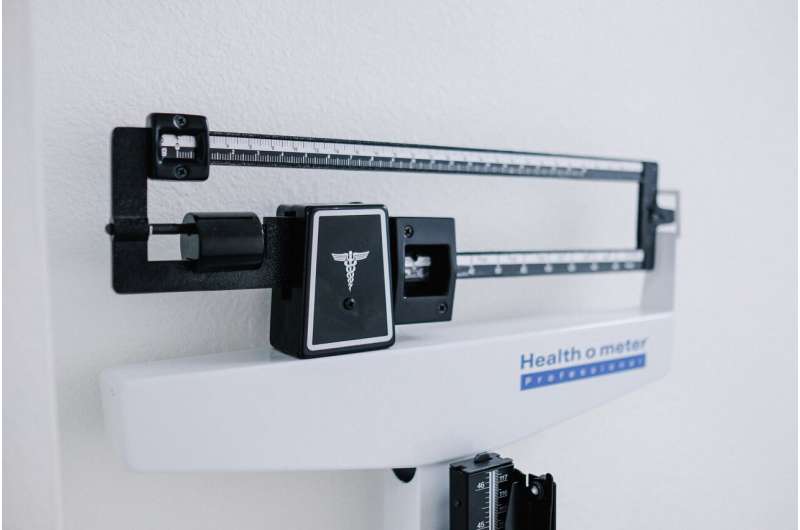Wide disparities in children's body fat between most deprived and advantaged areas

Children who live in the most deprived UK areas see far higher increases in body fat between the ages of seven and 17 compared to those from most advantaged areas, finds a new study by UCL researchers.
In the study, published in The Lancet Public Health, researchers found boys from the most deprived areas have a 3% higher fat mass index (FMI) at age seven compared to those from the most advantaged areas, and by 17 it is 23% higher.
Further, from the age of seven through to 17, these findings show there is an 11-fold increase in the difference in body fat gained among boys who live in the most deprived areas compared to peers from more advantaged socioeconomic areas.
For girls, at age seven FMI is 12% higher among those living in the most deprived areas compared to their peers in the most advantaged settings. By the time they are 17, there is an 18% difference. Further, from the age of seven through to 17, the study shows a three-fold increase (tripling) in the difference in body fat gained in girls between the two groups.
Lead author Charis Bridger Staatz, a Ph.D. student at UCL Institute of Education, said: "Our findings indicate a less healthy body composition among children growing up in disadvantaged socioeconomic circumstances compared to their more advantaged counterparts, and these differences increase with age up to 17 years. This is concerning because if widening of these inequalities persists into adulthood, this will result in large differences in body composition, with subsequent consequences for health inequalities."
Researchers looked at data from the Millennium Cohort Study, a nationally representative, ethnically diverse, birth cohort of 19,517 children born between 2000 and 2002. They followed 15,131 of these children and examined their body composition at four timepoints (at ages seven, 11, 14 and 17). Area deprivation was measured using the Index of multiple derivation, which includes housing, crime, health, education, income and employment levels of an area.
Not only did the authors see expected inequalities in fat, but they also noted significant differences/inequalities in the levels of 'fat-free mass', showing a far less healthy ratio of fat to fat-free mass among children in disadvantaged settings.
In all children, at age seven, the ratio of fat to fat-free mass was 5% higher among children in the most deprived areas, but by age 17 it was 30% higher.
Charis Bridger Staatz added that "because fat-free mass, which includes both muscle and bone mass, peaks at an earlier age than fat mass, inequalities established in childhood might be harder to address in later life."
The study, funded by the Medical Research Council and the Economic and Social Research Council, is one of the first to look at young people's body composition measures in the most deprived and most advantaged areas while accounting for their own family socioeconomic background.
Charis Bridger Staatz says that their "findings reinforce the need for effective policies to tackle inequalities in obesity in childhood that consider differences in the environment. We know in the UK that disadvantaged areas have higher density of fast-food outlets and it is possible this, along with other obesogenic characteristics of the environment more common in deprived settings, is contributing to the stark inequalities we observe.
"Our results also suggest a need to consider promotion of physical activity in disadvantaged areas from an early age to improve the quality of fat-free mass, especially muscle, and the ratio of fat to fat-free mass. Steps taken earlier can reduce the need for public health interventions at later ages, where such measures might be less effective at reducing inequalities."
Senior author, Professor Rebecca Hardy (UCL Institute of Education), said that "by looking at the areas in which people live as well as their individual circumstances, the study starts to untangle the role of neighborhood environments, which may influence body composition through characteristics of the area such as fast-food density and green space access."
The Fat Mass Index is usually calculated by dividing an individual's fat weight in kilograms by height in meters squared. This paper adopts a different approach to calculate FMI, where instead of using height in meters squared, the authors have calculated the most accurate number to raise height to (denoted by "B" in the paper), so that fat mass is no longer correlated with how tall the individual is. FMI is deemed as a better indicator of body composition measuring the body's fat and provides a more accurate picture of adiposity (how overweight one is) than body mass index (BMI).
The 11 times increase refers to the increase in difference in FMI at the two ages—at age seven there is a 0.054 kg/mB difference between the two groups, and by age 17 this is 0.6.
The tripling refers to the increase in difference in FMI at the two ages—at age seven there is a 0.22 kg/mB difference in FMI between the two groups, and by 17 it is 0.61.
More information: Charis Bridger Staatz et al, Area-level and family-level socioeconomic position and body composition trajectories: longitudinal analysis of the UK Millennium Cohort Study, The Lancet Public Health (2021). DOI: 10.1016/S2468-2667(21)00134-1















